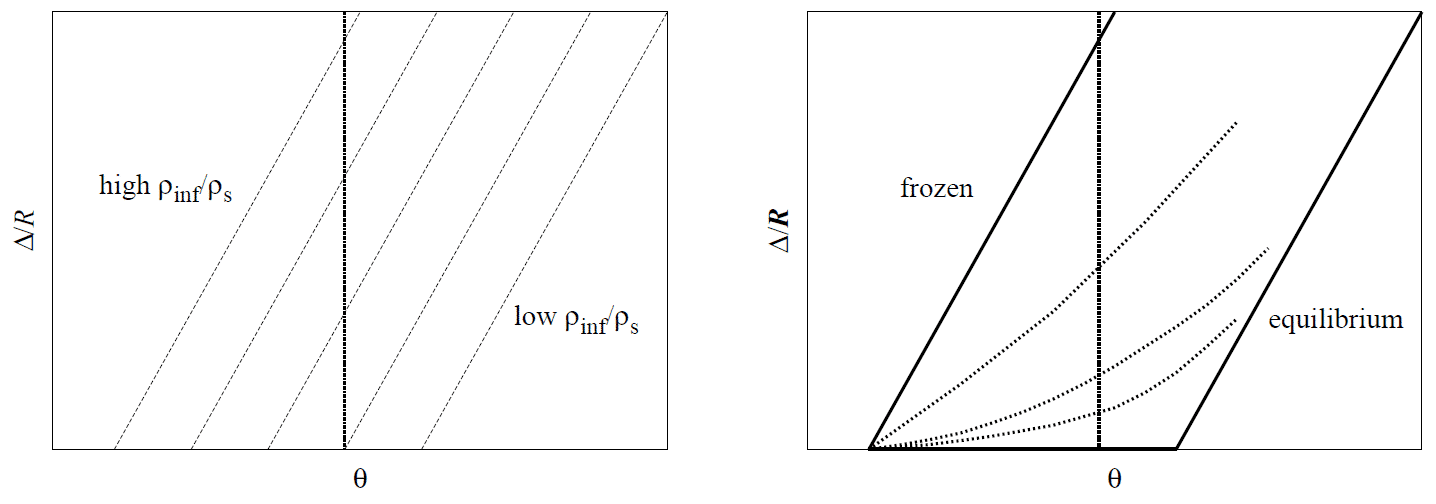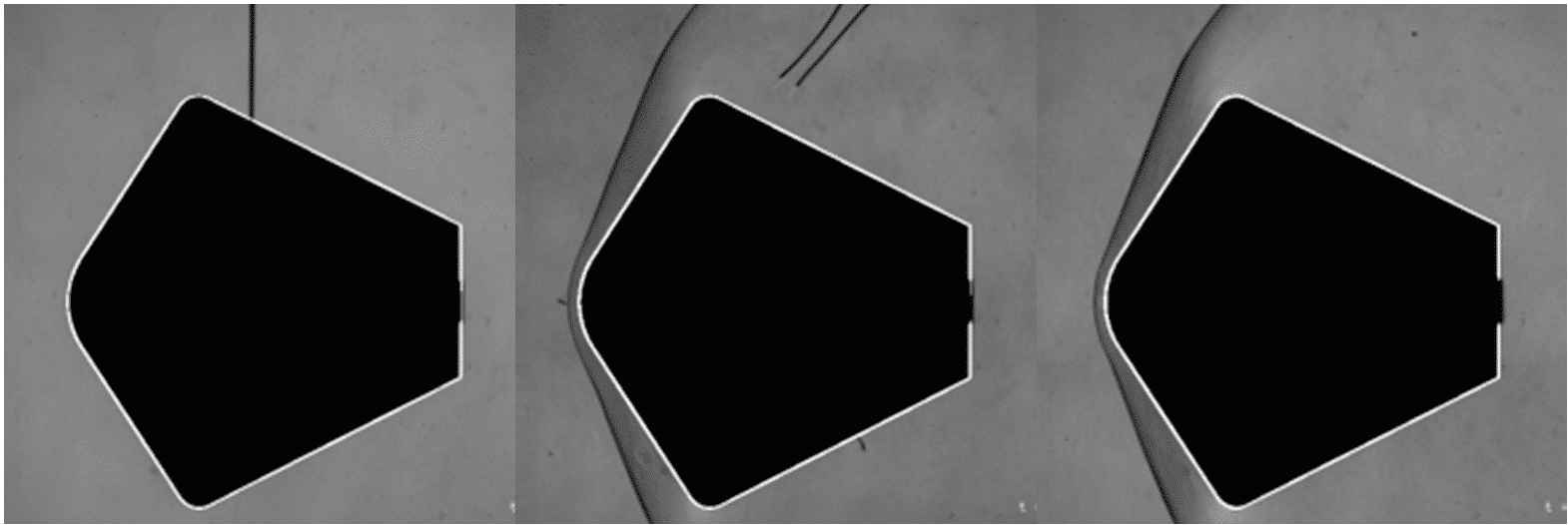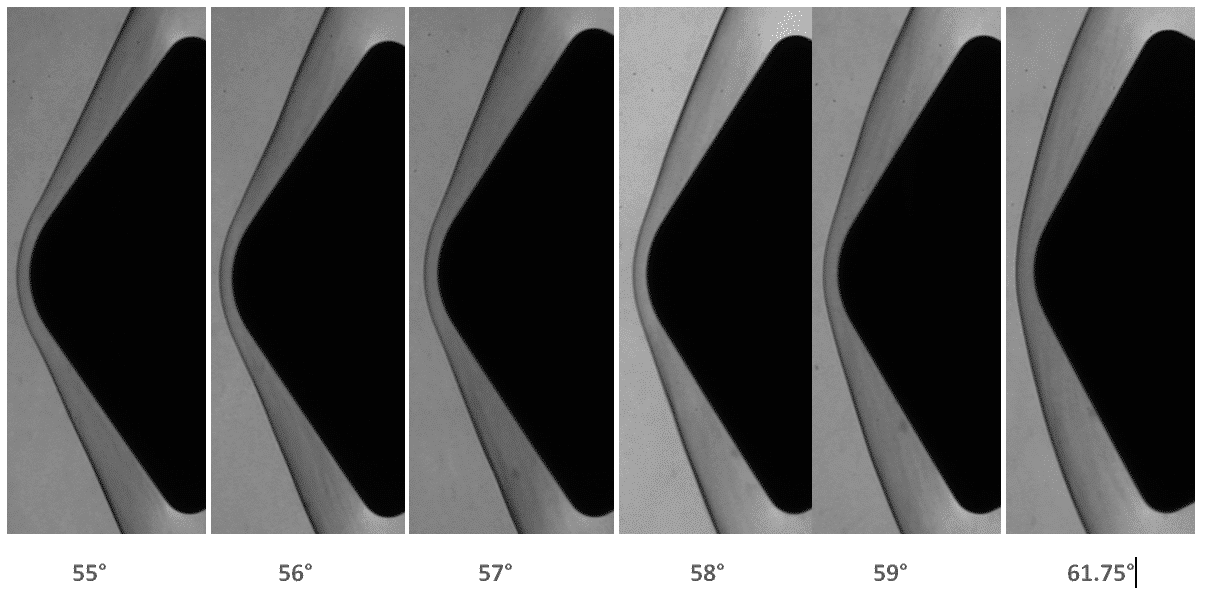In a computational and theoretical study [2] we investigated how different reentry shapes behave as a consequence of changes in the density ratio across a shock wave. For a sharp cone of a given angle, the stand–off distance increases linearly with r∞/rS from a critical onset point; here, r∞ is the free stream density and rS is the average density along the stagnation streamline. Considering the same situation for or a spherically blunted cone, a relatively sudden transition occurs between sphere behavior and sharp cone behavior. This transitional behavior is very undesirable for stability and heat–flux reasons. Since the density ratio is very sensitive to reaction rate in flows with vibrational and chemical relaxation, these phenomena are very important for entries of such vehicles into atmospheres of planets. The sketches of figure 1 illustrate the features of the flows of interest here. When the angle of a sharp cone in a steady supersonic flow is increased, there comes a point at which a sonic line appears at the surface of the cone. As the angle is increased further, the sonic line moves toward the shock wave, and reaches it at the point of shock detachment. Further increase of the cone angle causes the shock to detach by a distance which increases linearly with further shock angle increase. This is illustrated in the left part of Fig. 1 corresponding to perfect–gas or frozen flow. For decreasing values of r∞/rS the detachment angle increases.

Figure 1: Sketches of the behavior of the shock standoff distance on a sharp cone.
The situation is different for reacting flow. This is illustrated by the sketch on the right of figure 1. Here the detachment angle for frozen flow is significantly smaller than that for equilibrium flow. In each of these limits, Δ/R increases linearly with further increase of cone angle. However, at intermediate values of the density ratio where nonequilibrium effects apply, all the curves for different density ratios emanate from the frozen detachment point [6]. In this paper we aim to confirm our theoretical considerations [2] by performing experiments in the High Enthalpy Shock Tunnel Göttingen, HEG [1] of the German Aerospace Center in Germany (DLR). The experiments were conducted using capsule models of varying cone angles. The capsule models with a fixed base radius of 20 mm, shoulder radius of 4 mm and an approximate mass of 0.5 kg where imaged by high speed cinematography during the tests. The unique feature of these test were that the models were free flying during the test time in HEG and each test was performed with a new model. This elegantly simple method which allows the model to fly freely in the flow and to determine the forces from the resulting motion [5] has been improved and adopted to HEG [3][4]. In figure 2 a sequence of three images extracted from a high speed movie shows one of the capsule models prior to the arrival of the test gas, during the detachment phase from the retaining kevlar threads and during the free flight period.

Figure 2: Free flying capsule model in HEG (left: prior to experiment, middle: strings detach, right: test time).
The experiments in HEG were conducted at 3 MJ/kg and 12 MJ/kg specific enthalpy, corresponding to flow speeds of 2.4 km/s and 4.7 km/s, respectively. The cone angles of the capsules varied between 58° and 62°. The figure 3 shows experiments at 3 MJ/kg with varying cone angles. It is evident how the shock shape changes with increasing cone angle of the capsules.

Figure 3: Series of experiments at 3 MJ/kg with increasing cone angle of the capsule. The change in shock shape is clearly visible.
The paper will summarize the experimental results, compare them to the analytical and numerical results already presented [2] and conclude on the impact of the assumption made so far. Besides the time resolved shock stand-off distance, the shock shapes will be determined and discussed. Additionally the forces on the capsule models will be recovered from the optically tracked motion.
[1] Hannemann, K., Martinez Schramm, J., Karl, S., Recent extensions to the High Enthalpy Shock Tunnel Göttingen (HEG), Proceedings of the 2nd International ARA Days "Ten Years after ARD", Arcachon, France, 21-23 October, 2008
[2] Hornung, H.G., Martinez Schramm, J. and Hanneman, K., Sonic line and stand–off distance on re–entry capsule shapes, Proceedings of the 28th International Symposium on Shock Waves held in Manchester UK, 17 to 22 July 2011, Vol 1,Konstantinos Kontis (Ed.), Springer, 2012
[3] Laurence, S.J., Karl, S., An improved visualization-based force-measurement technique for short-duration hypersonic facilities, Exp Fluids, 48(6):949—965, 2011
[4] Laurence, S.J., On tracking the motion of rigid bodies through edge detection and least-squares fitting, Exp Fluids, 52(2):387—401, 2012
[5] Laurence, S.J. and Hornung, H.G., Image-based force and moment measurement in hypersonic facilities, Exp. in fluids 46:343-353, 2009
[6] Leyva, I.A., Shock detachment from a cone in reacting flow. In: Ball GJ, Hillier R and Roberts GT (eds.) Proceedings of the 22nd International Symposium on Shock Waves, Southampton University Media, 2000

